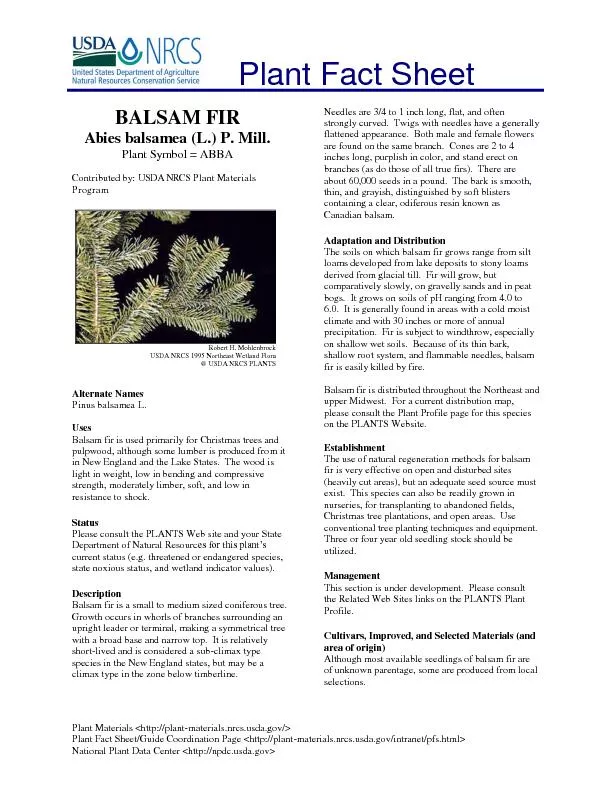/


Plant Fact Sheet Plant Mate materialsnrcsusdagov Plant Fact SheetGuide Coordination Page httpplant materialsnrcsusdagovintranetpfshtml National Plant Data Center ttpnpdcusdago ID: 317201
Download Pdf The PPT/PDF document "rials ttp://plant" is the property of its rightful owner. Permission is granted to download and print the materials on this web site for personal, non-commercial use only, and to display it on your personal computer provided you do not modify the materials and that you retain all copyright notices contained in the materials. By downloading content from our website, you accept the terms of this agreement.
Contributed by: USDA NRCS Plant Materials Alternate Names Pinus balsamea L. Uses Balsam fir is used primarily for Christmas trees and pulpwood, although some lumber is produced from it in New England and the Lake States. The wood is light in weight, low in bending and compressive Needles are 3/4 to 1 inch long, flat, and often strongly curved. Twigs with needles have a generally flattened appearance. Both male and female flowers are found on the same branch. Cones are 2 to 4 inches long, purplish in color, and stand erect on branches (as do those of all true firs). There are Balsam fir is distributed throughout the Northeast and upper Midwest. For a current distribution map, Establishment The use of natural regeneration methods for balsam fir is very effective on open and disturbed sites (heavily cut areas), but an adequate seed source must exist. This species can also be readily grown in nurseries, for transplanting to abandoned fields, Christmas tree plantations, and open areas. Use conventional tree planting techniques and equipment. Three or four year old seedling stock should be utilized. Prepared By & Species Coordinator: USDA NRCS Northeast Plant Materials Program 31Jan2002 JLK; 24may06jsp For more information about this and other plants, please contact your local NRCS field office or Conservation District, and visit the PLANTS Web site http://plants.usda.gov � or the Plant Materials Program Web site http://Plant-Materials.nrcs.usda.gov � The U.S. Department of Agriculture (USDA) prohibits s and activities on the basis of igin, sex, religion, age, disability, political beliefs, sexual orientation, and marital or family status. (Not all prohibited bases apply to all programs.) Persons with disabilities who require alternative means for communication of program information (Braille, large print, audiotape, etc.) should contact TARGET Center at 202-720-2600 (voice and TDD). tion write USDA, Director, Office of Civil Rights, Room 326-W, Whitten Building, 14th and Independence Avenue, SW, Washington, DC 20250-9410 or call 202-720-5964 (voice or TDD). USDA is an equal opportunity provider and employer. Read about Civil Rights at the Natural Resources Convervation Service .